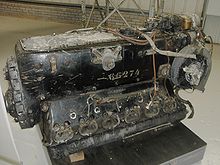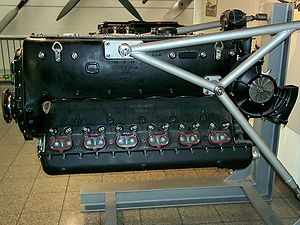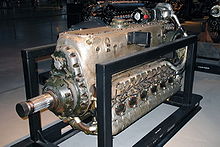- Daimler-Benz DB 601
-
DB 601 Preserved Daimler-Benz DB 601. Type Piston V12 aircraft engine National origin Germany Manufacturer Daimler-Benz First run 1930s Major applications Messerschmitt Bf 109 Developed from Daimler-Benz DB 600 Variants Aichi Atsuta
Kawasaki Ha-40Developed into Daimler-Benz DB 603
Daimler-Benz DB 605 One of the DB 601 engines from Rudolf Hess's Messerschmitt Bf 110 on display at the National Museum of Flight in Scotland.
One of the DB 601 engines from Rudolf Hess's Messerschmitt Bf 110 on display at the National Museum of Flight in Scotland.
The Daimler-Benz DB 601 was a German aircraft engine built during World War II. It was a liquid-cooled inverted V12, and powered the Messerschmitt Bf 109, among others. The DB 601 was basically an improved DB 600 with direct fuel injection.
The DB 601Aa was licence-built in Japan by Aichi as the Atsuta, by Kawasaki as the Ha-40, and in Italy by Alfa Romeo as the R.A.1000 R.C.41-I Monsone.
Contents
Development
Based on the guidelines laid down by the Reichswehrministerium ("Reich's Ministry of Defence"), in 1929[clarification needed] Daimler-Benz began development of a new aero engine of the 30-litre class: a liquid-cooled inverted-Vee 12-cylinder piston engine.[1] This was designated F4, and by 1931 two prototypes were running on the test bench.[1] These were followed by the improved F4 B, which became the prototype for the DB 600.[1]
In 1933, Daimler-Benz finally received a contract to develop its new engine and to build six examples of the DB 600.[1] For the year after, the DB 600 was the only German aero engine in the 30-litre class.[1] In total, 2281 DB 600s were built.[1]
The DB 601A-1 was a development of the DB 600 with direct fuel injection. Like all DB 601s, it had a 33.9 litre displacement.[1] The first prototype with the direct fuel injection, designated as F4E, was test run in 1935, and an order for 150 engines was placed in February 1937.[1]
Serial production begun in November 1937, and ended in 1943, after 19,000 examples of all types were produced.[1]
Variants
- DB601 A-1
- Up to 1,100 PS (809 kW) at sea-level with 2,400 rpm, up to 1,020 PS (750 kW) at 2,400 rpm and 4.5 km altitude, B4 fuel
- DB601 Aa
- Up to 1,175 PS (864 kW) at sea-level with 2,500 rpm, up to 1,100 PS (809 kW) at 2,400 rpm and 3.7 km altitude, B4 fuel
- DB601 B-1/Ba
- Same as DB601 A-1/Aa for use in Messerschmitt Bf 110 and/or bomber aircraft (different prop/engine ratio, 1:1.88 instead of 1:1.55)
- DB601N
- Up to 1,175 PS (864 kW) at sea-level and at 4.9 km altitude with 2,600 rpm, C3 fuel
- Up to 1,270 PS (934 kW) at 2.1 km altitude with 2,600 rpm
- DB601P
- Same as DB601N for use in Messerschmitt Bf 110 and/or bomber aircraft (different prop/engine ratio, 1:1.88 instead of 1:1.55)
- DB601E
- Up to 1,350 PS (993 kW) at sea-level with 2,700 rpm, up to 1,320 PS (970 kW) with 2.700 rpm at 4.8 km altitude, B4 fuel
- Up to 1,450 PS (1,066 kW) at 2.1 km altitude with 2,700 rpm
- DB601F/G
- Same as DB601E for use in Messerschmitt Bf 110, Messerschmitt Me 210 and/or bomber aircraft (different prop/engine ratio,1:1.875 (601F), 1:2.06 (601G) instead of 1:1.685)
- DB606A/B
- Two DB601F or G coupled to work on a single propeller shaft for use in early Heinkel He 177 - 2,700 PS (1,986 kW) at sea level, and derided as "welded-together engines" by Reichsmarschall Hermann Goering in the summer of 1942, from the problems they caused with engine fires in the He 177A during service.
Applications
- DB 601
- Dornier Do 215
- Heinkel He 100
- Henschel Hs 130A-0
- Kawasaki Ki-60
- Messerschmitt Bf 109
- Messerschmitt Bf 110
- Messerschmitt Me 210
- DB 606
Licensees
- Aichi Atsuta
- Alfa Romeo RA 1000 RC 41
- Kawasaki Ha-40
Specifications (DB 601Aa)
Data from [2]
General characteristics
- Type: Twelve-cylinder liquid-cooled supercharged 60° inverted Vee aircraft piston engine
- Bore: 150 mm (5.91 in)
- Stroke: 160 mm (6.30 in)
- Displacement: 33.93 L (2,070.5 in³)
- Length: 1,722 mm (68 in)
- Dry weight: 590 kg (1,320 lb)
Components
- Valvetrain: Two intake and two sodium-cooled exhaust valves per cylinder actuated via a single overhead camshaft per cylinder block.
- Supercharger: Gear-driven single-speed centrifugal type supercharger (later, hydraulic-driven[3])
- Fuel system: Direct fuel injection
- Oil system: Dry sump with one pressure and two scavenge pumps
- Cooling system: Liquid-cooled
Performance
- Power output:
- 865 kW (1,175 PS or 1,159 hp) at 2,500 rpm for takeoff
- 787 kW (1,070 PS or 1,050 hp) at 2,400 rpm at 3,700 m (12,140 ft)
- Specific power: 25.52 kW/l (0.56 hp/in³)
- Compression ratio: 6.9:1
- Specific fuel consumption: 270 g/(kW·h) (0.44 lb/(hp·h))
- Power-to-weight ratio: 1.47 kW/kg (0.89 hp/lb)
See also
- Related development
- Daimler-Benz DB 600
- Daimler-Benz DB 603
- Daimler-Benz DB 605
- Aichi Atsuta
- Kawasaki Ha-40
- Comparable engines
- Allison V-1710
- Continental I-1430
- Hispano-Suiza 12Y
- Junkers Jumo 211
- Klimov M-105
- Mikulin AM-35
- Rolls-Royce Merlin
- Related lists
References
Notes
- ^ a b c d e f g h i Mankau&Petrick, 2001. pp. 347-355
- ^ Tsygulev (1939). Aviacionnye motory voennykh vozdushnykh sil inostrannykh gosudarstv (Russian: Авиационные моторы военных воздушных сил иностранных государств). Moscow: Gosudarstvennoe voennoe izdatelstvo Narkomata Oborony Soyuza SSR. http://base13.glasnet.ru/text/aviamotory/t.htm.
- ^ Wilkinson, Stephan (Jan 2003). "With the Noise of a Stone Crusher". Popular Science. http://books.google.com/books?id=WAAAAAAAMBAJ&lpg=PA29&dq=supercharger%20Daimler&pg=PA28#v=onepage&q&f=false.
Bibliography
- Mankau, Heinz and Peter Petrick. Messerschmitt Bf 110, Me 210, Me 410. Raumfahrt, Germany: Aviatic Verlag, 2001. ISBN 3-92550-562-8.
- Neil Gregor Daimler-Benz in the Third Reich. Yale University Press, 1998
External links
- Daimler-Benz Aircraft Engines
- Aviation History.com, DB 600 series page
- Kurfürst - Resource on Messerschmitt Bf 109 performance.
Daimler-Benz aircraft engines Piston engines Turbofans 109-007 · DB 730
Turboprops/Turboshafts 109-021 · DB 720 · DB 721
Lists relating to aviation General Aircraft (manufacturers) · Aircraft engines (manufacturers) · Airlines (defunct) · Airports · Civil authorities · Museums · Registration prefixes · Rotorcraft (manufacturers) · TimelineMilitary Accidents/incidents Records Categories:- Daimler-Benz aircraft engines
- Aircraft piston engines 1930-1939
Wikimedia Foundation. 2010.



